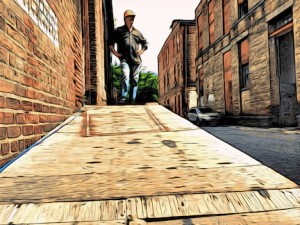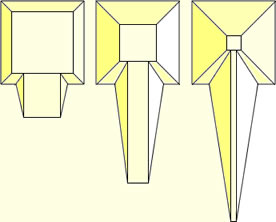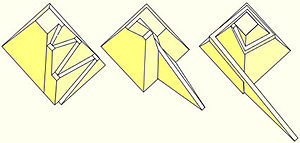I never really watched much science fiction as a kid, but my boys loved it. Dragged me to all those Star Wars movies, always had Star Trek and all those other space shows on  the TV. I can’t say as I’m a huge fan now, but I can definitely see the appeal. (Except for robots. We’ve already lost enough jobs to them; manufacturing lines hardly even need people anymore.)
the TV. I can’t say as I’m a huge fan now, but I can definitely see the appeal. (Except for robots. We’ve already lost enough jobs to them; manufacturing lines hardly even need people anymore.)
Something always bothered me about a lot of those movies, though, and I only recently figured out what.
In Star Wars, when they want to travel between ships they climb the ramp into a shuttle, raise the ramp, fly over, lower the ramp. When they’re delivering cargo, same thing. It makes sense.
In Star Trek, though, they have teleporters, and they use them all the time. I don’t know if that stuff is possible, but it just nagged at me until I realized: they’re basically like lifts.
When you’re loading or unloading something, a ramp is almost always going to be cheaper, easier, and faster. Not always by much, but it will be. Less upkeep, too.  I don’t know how much power teleporters use, but I feel like it can’t be cheap to run one. Plus, the teleporters come out in those nice, carpeted rooms. They can’t possibly load all their stuff from there. There’d be marks all over the carpet.
I don’t know how much power teleporters use, but I feel like it can’t be cheap to run one. Plus, the teleporters come out in those nice, carpeted rooms. They can’t possibly load all their stuff from there. There’d be marks all over the carpet.
Since they have imitation gravity on those things, why don’t they just lower the gravity there and push them up ramps like they’re full of feathers? Heck, you’ll be saving on power this way.
I know I’m being nitpicky here, but it kinda feels like the writers on the show assumed that technology would get rid of the need for logistics. You’re always going to need to load and unload things, no matter how many years in the future you are and, if you ask me, teleporters aren’t going to replace ramps anytime soon.


 The Aztecs were real tricky to find stuff on. Almost every supposed “source” detailing its construction techniques immediately starts going on about how they sacrificed people during construction, then doesn’t bother to actually discuss the techniques they used. I’m no trained historian, but that seems like sensationalism to me, and it sure doesn’t answer my questions.
The Aztecs were real tricky to find stuff on. Almost every supposed “source” detailing its construction techniques immediately starts going on about how they sacrificed people during construction, then doesn’t bother to actually discuss the techniques they used. I’m no trained historian, but that seems like sensationalism to me, and it sure doesn’t answer my questions. The Incans were the easiest to find information on, since most of the stuff on the Internet is about their construction techniques anyhow. Their buildings were famed for being constructed of huge stone blocks in irregular patterns that for together perfectly, without gaps. You can’t even stick a knife between the stones.
The Incans were the easiest to find information on, since most of the stuff on the Internet is about their construction techniques anyhow. Their buildings were famed for being constructed of huge stone blocks in irregular patterns that for together perfectly, without gaps. You can’t even stick a knife between the stones. I had a brand new Schwinn, and he had one of those heavy black Raleigh bikes from England. The boards were resting on the cinder block at about a 45-degree angle. I went first, on account of John being quite a bit smarter than me. I moved right up against his house to get the fastest start I could. I came at the ramp straight on and made it onto the board I was aiming at, which then promptly broke in half, and I crashed full speed into the cinder blocks.
I had a brand new Schwinn, and he had one of those heavy black Raleigh bikes from England. The boards were resting on the cinder block at about a 45-degree angle. I went first, on account of John being quite a bit smarter than me. I moved right up against his house to get the fastest start I could. I came at the ramp straight on and made it onto the board I was aiming at, which then promptly broke in half, and I crashed full speed into the cinder blocks. John, meanwhile, hadn’t bothered to watch me go down. When he saw me ramp, he just had to go himself. He used a different, longer board than I did. As soon as his back wheel hit the end of the board, it flipped up into the air like it were part of a catapult, flew through the air, and somehow managed to land on one end on my injured arm between the wrist and elbow, breaking it a second time before bouncing farther down the hill.
John, meanwhile, hadn’t bothered to watch me go down. When he saw me ramp, he just had to go himself. He used a different, longer board than I did. As soon as his back wheel hit the end of the board, it flipped up into the air like it were part of a catapult, flew through the air, and somehow managed to land on one end on my injured arm between the wrist and elbow, breaking it a second time before bouncing farther down the hill. The ancient Egyptians obviously didn’t have the technology for moving heavy loads that we did. All they had were a few primitive cranes, some basic levers and rollers, and, of course, ramps.
The ancient Egyptians obviously didn’t have the technology for moving heavy loads that we did. All they had were a few primitive cranes, some basic levers and rollers, and, of course, ramps. It seems more likely that they instead either zigzagged the ramp up one side or spiraled it around the pyramid, using uncompleted segments as the ramp. This would have allowed them to construct the vast majority of the pyramid easily, though the top third of the structure would have needed to be moved up, using levers. Since it’s so much narrower at the top, though, that top third makes up less than five percent of the total weight of the pyramid. That’s working smart.
It seems more likely that they instead either zigzagged the ramp up one side or spiraled it around the pyramid, using uncompleted segments as the ramp. This would have allowed them to construct the vast majority of the pyramid easily, though the top third of the structure would have needed to be moved up, using levers. Since it’s so much narrower at the top, though, that top third makes up less than five percent of the total weight of the pyramid. That’s working smart.